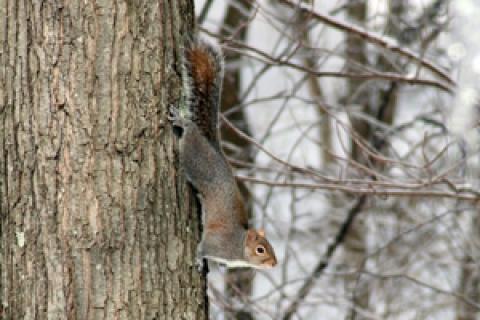
 For many hikers and campers, the winter season is a season filled with frosty landscapes and chilly sunsets, but something is missing or rarely seen — wildlife. Unless of course, you hike or camp in warmer climates. But for those that are annually dusted with snow and frigid temperatures, the critters that provide photo opps and wildlife watching fun are in winter survival mode. What happens to the animals that have given you much entertainment while camping and hiking during the other three seasons?
For many hikers and campers, the winter season is a season filled with frosty landscapes and chilly sunsets, but something is missing or rarely seen — wildlife. Unless of course, you hike or camp in warmer climates. But for those that are annually dusted with snow and frigid temperatures, the critters that provide photo opps and wildlife watching fun are in winter survival mode. What happens to the animals that have given you much entertainment while camping and hiking during the other three seasons?
Wildlife does one of three things: hibernate, adapt or migrate for the winter. For animals to adapt, nature has supplied the creatures with built-in mechanisms that initiate changes to the animal's body so it may endure the changes of the season. To keep warm, the animal will grow a thicker coat of fur, but even so, a steady supply of energy is a must.
Deer and rabbits scrounge for leftovers: leaves, twigs, nuts hidden under a carpet of decaying leaves, and any remnants of agricultural crops lying in the fields. The cottontail rabbit will eat the blandest fare in the wild — tree bark and twigs — but the rabbit is not an extremely active animal in winter. The cottontail huddles in its "squat" until the warmest time of the day when it cruises for a meal. In early spring, you may see the damage a few inches from ground level to tree saplings, a girdling ring of the bark, caused by rabbits.
Squirrels, muskrats and beaver will store their food in the fall for later eating. Squirrels are not true hibernators, but they are "torpor" hibernators. Torpor hibernators are short-term hibernators, falling into a deep sleep during extremely cold nights, but can be easily awakened. Some squirrels will sleep for a few days at a time waking up for a snack and then right back to bed to conserve the energy gained from the meal.
The true hibernator doesn't store any food away for winter eating. The true hibernator has provided itself with a thick layer of fat between its muscle and skin that will be drawn from to sustain the animal during its winter nap. The absorbed fat does not enter the digestive system, but goes directly into the muscle and blood structure. During hibernation, the animals' life support system is nearly shut down. The body temperature drops, breathing is slowed, and the metabolism of the animal is reduced to just enough to stay alive. A species of the Rocky Mountain ground squirrels body temperature drops to only three degrees above the freezing point of water. It is said that when the squirrel is removed from its den, it looks as if it has frozen to death. But once the squirrel is warmed up, the small rodent will spring into activity once more as if spring has arrived.
The most famous hibernator is not truly a deep hibernator. Many photos and stories are told about the bear's winter siesta. The primary reason that a bear hibernates is that it has no, or a greatly diminished, food supply.
Most mammals either adapt or hibernate for the winter, but some do migrate, even if only a short distance. The white-tailed deer and its relatives such as the elk will move or adjust their location for the winter. The driving factor for their mini-migration is for the betterment of habitat. The split-hoofed animals will move to and remain at a wintering area — it may be only less than a mile from its summer area — that provides protection from the cold wind and driving snow with a decent food supply. Hawks and owls actually fly south until they locate an area that offers good hunting. If a sufficient supply of food is available for the birds of prey they will remain in their home range for the winter.
There is still plenty of animal action in the wild during the winter months. Break free from your hibernation activities and go explore.
- 3676 views

